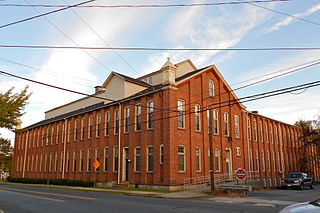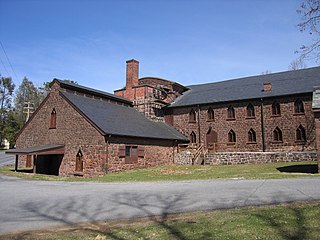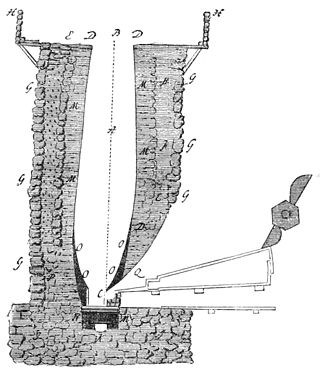
Lock Ridge Park is a park built around a historic iron ore blast furnace just outside Alburtis, Pennsylvania in the Lehigh Valley region of eastern Pennsylvania.

Lock Ridge Park is a park built around a historic iron ore blast furnace just outside Alburtis, Pennsylvania in the Lehigh Valley region of eastern Pennsylvania.
The park preserves portions of the former Lock Ridge Iron Works. The first furnace at the site was built in 1868 by the Lock Ridge Iron Company, on the line of the Catasauqua and Fogelsville Railroad near its junction with the East Pennsylvania Railroad. The company was taken over the next year by the Thomas Iron Company, and a second furnace put in blast shortly thereafter. The iron industry in the Lehigh Valley was then flourishing, and the Lock Ridge furnaces, designated No. 7 and No. 8 by Thomas Iron, were typical of the time. Rather than common charcoal, they used a hot blast to burn anthracite fuel, a technology brought to the United States by the company's founder, David Thomas, in 1839
By the early 20th century, however, the furnaces were, despite sporadic improvements, technologically out-of-date, [1] and were reputedly the last anthracite iron furnaces operating in the United States. B. F. Fackenthal, president of Thomas Iron, recommended they be decommissioned upon his resignation in 1913.
Fackenthal's successor, Ralph Sweetser, pursued the opposite course. No. 8 furnace stack was rebuilt in 1914, and No. 7 the following year. [2] Concurrently, anthracite was replaced by coke as a fuel for the furnaces. [3] However, modernization was not enough to save the Lock Ridge furnaces, and iron was last made there in 1921. [4]
The furnaces were sold to William Butz, who dismantled most of the buildings for scrap iron and lumber. The masonry structures, however, were allowed to remain, but in a decayed condition. The slag dumps on the property were crushed, screened, and used for roofing and fill by the Lehigh Slag Company until 1958. Little-used since the closing of the furnaces, the Catasauqua and Fogelsville's rail lines through the site was torn up in the 1940s. With industrial operations on the property long complete, it was donated by the Butz family to Lehigh County for use as a park. [5]
In August 1976, Lock Ridge Park was opened as a 59.2 acres (24.0 ha) public park. It is operated as a partnership between Lehigh County, which owns and maintains the site, and the Lehigh County Historical Society, which provides public tours of the furnace complex. The park is made up of the remains of the old furnace complex, now the Lock Ridge Furnace Museum, and the land surrounding it.
Swabia Creek, which flows through the park grounds, offers limited fishing. The park also features a Little League Baseball field and a picnic pavilion with restrooms and a fireplace. The park also features a self-guided walking tour of the site. [6]

Catasauqua, referred to colloquially as Catty, is a borough in Lehigh County, Pennsylvania, United States. Catasauqua's population was 6,518 at the 2020 census. It is a suburb of Allentown in the Lehigh Valley, which had a population of 861,899 and was the 68th-most populous metropolitan area in the U.S. as of the 2020 census.

David Thomas was a native of Wales who was influential in the birth of the Industrial Revolution in the United States.
Anthracite iron or anthracite pig iron is iron extracted by the smelting together of anthracite coal and iron ore, that is using anthracite coal instead of charcoal in iron smelting. This was an important technical advance in the late-1830s, enabling a great acceleration of the Industrial Revolution in the United States and in Europe.
Fogelsville is a village in Lehigh County, Pennsylvania. It is a suburb of Allentown, in Upper Macungie Township, and is part of the Lehigh Valley, which has a population of 861,899 and was the 68th-most populous metropolitan area in the U.S. as of the 2020 census.

Hot blast refers to the preheating of air blown into a blast furnace or other metallurgical process. As this considerably reduced the fuel consumed, hot blast was one of the most important technologies developed during the Industrial Revolution. Hot blast also allowed higher furnace temperatures, which increased the capacity of furnaces.

The Lehigh Crane Iron Company, later renamed Crane Iron Company, was a major ironmaking firm in the Lehigh Valley from its founding in 1839 until its sale in 1899. It was based in Catasauqua, Pennsylvania, and was founded by Josiah White and Erskine Hazard, who financed its development through their Lehigh Coal & Navigation Company, which promoted the then-novel technique of smelting iron ore with anthracite coal. This was an important cost and energy savings technique, credited with eliminating the need for either expensive charcoal or coke producing processes and transport costs that proved central to the acceleration of the American industrial revolution.

The Thomas Iron Company was a major iron-making firm in Hokendauqua, Pennsylvania in the Lehigh Valley region of eastern Pennsylvania from its founding in 1854 until its decline and eventual dismantling in the early 20th century. The company was named in honor of its founder, David Thomas, who emigrated to the United States in 1839 to introduce hot blast iron making in the Lehigh Valley, and later embarked on an independent ironmaking venture.
Rittenhouse Gap is the name of a village in Longswamp Township in Berks County, Pennsylvania, United States, situated at 40°28′04″N75°37′47″W.
The Catasauqua and Fogelsville Railroad was built in the 1850s to transport iron ore from local mines in Lehigh and later Berks County to furnaces along the Lehigh River in eastern Pennsylvania. Originally owned by two iron companies, the railroad later became part of the Reading Company, and parts of it remain in operation today.

Cornwall Iron Furnace is a designated National Historic Landmark that is administered by the Pennsylvania Historical and Museum Commission in Cornwall, Lebanon County, Pennsylvania in the United States. The furnace was a leading Pennsylvania iron producer from 1742 until it was shut down in 1883. The furnaces, support buildings and surrounding community have been preserved as a historical site and museum, providing a glimpse into Lebanon County's industrial past. The site is the only intact charcoal-burning iron blast furnace in its original plantation in the western hemisphere. Established by Peter Grubb in 1742, Cornwall Furnace was operated during the Revolution by his sons Curtis and Peter Jr. who were major arms providers to George Washington. Robert Coleman acquired Cornwall Furnace after the Revolution and became Pennsylvania's first millionaire. Ownership of the furnace and its surroundings was transferred to the Commonwealth of Pennsylvania in 1932.

Cold blast, in ironmaking, refers to a metallurgical furnace where air is not preheated before being blown into the furnace. This represents the earliest stage in the development of ironmaking. Until the 1820s, the use of cold air was thought to be preferable to hot air for the production of high-quality iron; this effect was due to the reduced moisture in cool winter air.

The Ironton Railroad was a shortline railroad in Lehigh County, Pennsylvania. Originally built in 1861 to haul iron ore and limestone to blast furnaces along the Lehigh River, traffic later shifted to carrying Portland cement when local iron mining declined in the early 20th century. Much of the railroad had already been abandoned when it became part of Conrail in 1976, and the last of its trackage was removed in 1984.

The Lehigh Coal & Navigation Company was a mining and transportation company headquartered in Mauch Chunk, Pennsylvania, in present-day Jim Thorpe, in Northeastern Pennsylvania. The company operated from 1818 until its dissolution in 1964 and played an early and influential role in the Industrial Revolution in the United States. The company ultimately encompassed source industries, transport, and manufacturing, making it the first vertically integrated U.S. company.
West Catasauqua is an unincorporated village in Whitehall Township in Lehigh County, Pennsylvania. Once a port and station along the busy Lehigh Canal, it is colloquially known as West Catty. It is part of the Lehigh Valley, which has a population of 861,899 and is the 68th-most populous metropolitan area in the U.S. as of the 2020 census.

Josiah White (1781–1850) was a Pennsylvania industrialist and key figure in the American Industrial Revolution.

Biery's Port Historic District is a national historic district located in Catasauqua, Pennsylvania in the Lehigh Valley region of eastern Pennsylvania. The district was added to the National Register of Historic Places in 1984 and includes 90 contributing buildings in the Biery's Port section of Catasauqua.
The Glendon Iron Company was an iron company in the Lehigh Valley, in Pennsylvania, in the United States. It was the second iron furnace in Lehigh Valley to be fueled by anthracite. The company was established in 1842 and disestablished in 1896. Its leaders were primarily based in Boston and Hazleton. The company's main methods of export were via the Lehigh Canal and the Morris Canal. The company started out with a single furnace, but eventually came to own five furnaces.

There are two types of coal found in Pennsylvania: anthracite, the hard coal found in Northeastern Pennsylvania below the Allegheny Ridge southwest to Harrisburg, and bituminous, the soft coal found west of the Allegheny Front escarpment). Anthracite coal is a natural mineral with a high carbon and energy content that gives off light and heat produced energy when burned, making it useful as a fuel. It was possibly first used in Pennsylvania as a fuel in 1769, but its history begins with a documented discovery near Summit Hill and the founding of the Lehigh Coal Mine Company in 1792 to periodically send expeditions to the wilderness atop Pisgah Ridge to mine the deposits, mostly with notable lack of great success, over the next 22 years.

Catasauqua Creek is an ENE–SSW oriented creek draining 6.6 miles (10.6 km) from springs of the Blue Mountain barrier ridge several miles below the Lehigh Gap in the Ridge-and-Valley Appalachians located upriver and opposite from Allentown in Lehigh and Northampton counties in the Lehigh Valley region of eastern Pennsylvania.
The Catasauqua Branch was a short railway line in Lehigh and Northampton Counties in the state of Pennsylvania. It was part of the Lehigh and New England Railroad and ran from a point south of Bath to Catasauqua, where it interchanged with the Central Railroad of New Jersey and Lehigh Valley Railroad. The line opened in 1914 and was partially abandoned in 1961 on the Lehigh and New England Railroad's bankruptcy and closure. Conrail abandoned the remainder in the 1990s.